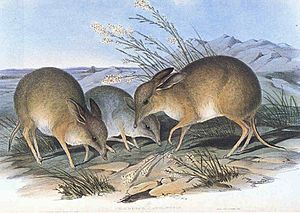Southern pig-footed bandicoot facts for kids
Quick facts for kids Southern pig-footed bandicoot |
|
|---|---|
 |
|
| Conservation status | |
| Scientific classification | |
| Subspecies | |
|
|
| Synonyms | |
|
The southern pig-footed bandicoot (Chaeropus ecaudatus) was a small marsupial that ate plants. It belonged to a group called pig-footed bandicoots. Sadly, this animal is now extinct.
Contents
Understanding the Southern Pig-footed Bandicoot
Scientists study how living things are related and give them names. This is called taxonomy. In 2019, experts looked closely at the southern pig-footed bandicoot. They decided to separate one group of them into a new species, called Chaeropus yirratji.
They also recognized two different types, or subspecies, of the southern pig-footed bandicoot:
- Chaeropus ecaudatus ecaudatus lived in southeastern Australia.
- Chaeropus ecaudatus occidentalis lived in western and southwestern Australia.
Life and Disappearance of the Bandicoot
The southern pig-footed bandicoot is believed to have become extinct around the mid-1900s. It was last seen in southern Australia by 1945. It was likely the first of the two pig-footed bandicoot species to disappear forever.
Unique Features of the Pig-footed Bandicoot
Pig-footed bandicoots were special because they were the only marsupials that walked on very small toes. Both their front and back feet had these reduced digits. This made them quite unique among marsupials.
Scientists have studied their genes to understand their family tree. They found that pig-footed bandicoots split off from other bandicoots (like Peramelidae) and bilbies (like Thylacomyidae) a very long time ago. This happened during a period called the mid-Late Oligocene.
Where They Lived and What They Ate
These bandicoots probably lived in shrublands in the southern parts of Australia's deserts. Their home range likely stretched all the way to Western Australia.
The southern pig-footed bandicoot looked a lot like the northern pig-footed bandicoot (C. yirratji). However, there were some small differences. The southern species had fewer holes in the roof of its mouth (its palate). It also had shorter feet. Its teeth were different too, which suggests it might have eaten different foods.
C. ecaudatus was good at adapting to its environment. As conditions became drier, it quickly changed its diet to become a grazer. This means it ate mostly grasses. Scientists believe this quick change to eating plants happened because an older species, Chaeropus baynesi, had teeth that could easily evolve for grazing.
Why They Disappeared
The two pig-footed bandicoot species were once thought to be the same. But a study in 2019 showed they were actually separate species.
Sadly, the southern pig-footed bandicoot likely went extinct for a few main reasons. New animals brought to Australia, like red foxes and feral cats, hunted them. Also, their homes were damaged by introduced farm animals like livestock.
See also
 In Spanish: Bandicut de pies de cerdo para niños
In Spanish: Bandicut de pies de cerdo para niños


